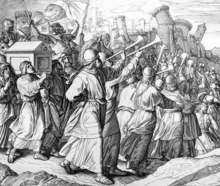Battle of Jerico
| Battle of Jericho (biblical) | |||||
|---|---|---|---|---|---|
 Depiction by Julius Schnoor von Carolsfeld (1794-1872) |
|||||
|
|||||
| Belligerents | |||||
| Israelites | Canaanites | ||||
| Commanders and leaders | |||||
| Joshua | King of Jericho † | ||||
| Strength | |||||
| 40,000 | Unknown | ||||
| Casualties and losses | |||||
| Nil | Herem | ||||
According to the Book of Joshua, the Battle of Jericho was the first battle of the Israelites in their conquest of Canaan. According to Joshua 6:1-27, the walls of Jericho fell after Joshua's Israelite army marched around the city blowing their trumpets. Excavations at Tell es-Sultan, the biblical Jericho, have failed to produce data to substantiate the biblical story, and scholars are virtually unanimous that the Book of Joshua holds little historical value.
The story of Jericho is told in Joshua 6:1-27.
The first five books of the Hebrew Bible tell how Noah cursed Canaan to become a slave, and how God gave the land of the Canaanites to Abraham and his descendants. The children of Israel (descendants of Abraham) themselves became slaves in Egypt, but through Moses God brought them out of Egypt and to the borders of the promised land of Canaan. There Moses instructed them to seize the land by conquest, and placed them under the command of Joshua.
Joshua sent spies to Jericho, the first city of Canaan to be taken, and discovered that the land was in fear of Israel and their God. The Israelites marched around the walls once every day for seven days with the priests and the Ark of the Covenant. On the seventh day they marched seven times around the walls, then the priests blew their ram's horns, the Israelites raised a great shout, and the walls of the city fell. Following God's law of herem the Israelites took no slaves or plunder but slaughtered every man, woman and child in Jericho, sparing only Rahab, a Canaanite prostitute who had sheltered the spies, and her family.
In 1868, Charles Warren identified Tell es-Sultan as the site of Jericho. In 1930–36, John Garstang conducted excavations there and discovered the remains of a network of collapsed walls which he dated to about 1400 BCE. Kathleen Kenyon re-excavated the site over 1952–1958 and demonstrated that the destruction occurred c.1500 BCE during a well-attested Egyptian campaign of that period, and that Jericho had been deserted throughout the mid-late 13th century. Kenyon's work was corroborated in 1995 by radiocarbon tests which dated the destruction level to the late 17th or 16th centuries. A small unwalled settlement was rebuilt in the 15th century, but the tell was unoccupied from the late 15th century until the 10th/9th centuries.
...
Wikipedia
